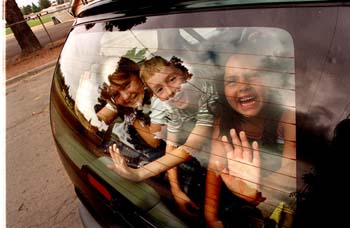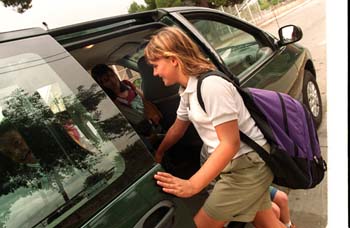![[Metroactive News&Issues]](/gifs/news468.gif)
[ San Jose | Metroactive Central | Archives ]
 Photograph by George Sakkestad Auto Focus: Back to school, for many, means hitting the road -- only not on a school bus. Hell on Wheels Adults aren't the only ones losing precious hours each day stuck in commuter hell. Whatever happened to the big yellow school bus? By Dara Colwell LIKE MOST COMMUTERS, Kellie Cervantes has a thorough working knowledge of the road--where the early morning gridlock clogs up like thick molasses, which exits are blocked by construction, the location of the best side-road detours, and an uncanny awareness of which stretch of asphalt signals a cop zone. While Cervantes' 30-mile, one-hour commute isn't the fists-clenched-to-the-steering-wheel drag many commuters face--she uses the carpool lane--her hectic morning scramble begins at 5:30am. "This is the lightest traffic I've ever seen," Cervantes says excitedly on one recent morning as her green Plymouth Voyager whisks past the El Grullense tacqueria on West San Carlos, a shortcut that heads her towards highway 87 South. "This is a good day." Just then one of Cervantes' passengers pipes up. "Slug bug! One point!" her niece Brittany, a seventh-grader at Luther Burbank School, shouts, pointing to an old Volkswagen skirting by on the passenger side. Cervantes' passengers--a brood ranging from 4-month-old Jared to Cervantes' first- and seventh-grade nieces--are off to school, winding their way through the South Bay's congested highways and, surprisingly, making good time. Like many parents driving their children to school, this Sunnyvale mother of four, donned in comfortable sweats, has become a fixture of daily traffic. Cervantes has put nearly 62,000 miles on her Plymouth in just over two years, which she attributes to the frantic haul getting her kids to and from school. Unlike many parents who drive, rather than sending their children onto overcrowded school buses, which, they say, frequently run late, Cervantes has no alternative. There is no bus route that runs from Sunnyvale to south San Jose, where her children began their public schooling. But as traffic congestion continues to build both on and off the freeway, it underlines an issue that large school districts like San Jose face--inadequate busing and, even more so, the inadequate funding to provide it. "Transportation is actually more of a privilege than a right," says Rose Bedard-Carr, manager of transportation planning and enterprise services for San Jose Unified School District, referring to the decision made by California's Supreme Court that transportation is not an educational requirement. "There are fewer and fewer dollars available to fund everything--and even fewer going to transportation." As a result, commuting is not an obstacle only cubicle-bound adults face. Although regular commuters cringe at the onset of school--which affects the 134,916 car trips already made in Santa Clara County during peak afternoon hours, according to the Valley Transit Authority--commuting has become a drawn-out routine for kids. Bused a Move AT 7:15 AM OUTSIDE PIONEER High School on Blossom Hill Road, several school buses drop students off, as a line of cars 20 deep edges the side of the road leading up to the school's parking lot. Freshman Cecelia Marsh, a pleasant-looking teen dressed casually in cream-colored cargo pants, gets off bus No. 27, run by Valley Transit Authority, and crosses the street. Marsh's morning commute begins every day at 6:10am when she walks from home, under darkened skies, with three of her brothers to the Capitol Expressway light-rail stop at Narvez. Half an hour later, they've transferred to the bus, now full of sleepy teenagers toting heavy backpacks. "I'd rather take this bus," Marsh says of the county's public system. When she took the school bus last year to Castillero Middle School, "there were three or four students to a seat and each stop was packed. Every day I was 20 minutes late." Sometimes, on the way back home, according to her mother, Marjorie Marsh, the bus would take "the scenic route," dropping her daughter off close to 5pm. "I decided to do my own busing and drive her to and from school," she says good-humoredly. "It eliminated the problem altogether." Marsh, who now drives three granddaughters to Hacienda Elementary School every morning after walking her youngest son to a neighborhood school, feels that the continual overcrowding has made her question school transportation as a viable way to get there. "I figure, my tax dollars don't work very well," she says plainly. "After I zigzag around for three hours a day, I get upset having to pay for public transportation just to make sure my kids get to school on time." Many parents and teens share the Marshes' dilemma--just witness the early morning public buses crowded with denim-clad high school students who have been forced to tap their resources just to get to class. A monthly youth pass on VTA costs $22. But added up over the course of the school year, that's a good $200.
The Road Well Traveled: Brittany Robinson heads to class. Wheel Deals SAN JOSE UNIFIED SCHOOL District stretches from the northern expanse near Hostetter Road to the tapered southern section off Almaden Expressway. The district schools 32,000 students, but only 11,000 are eligible for bus service due to walking distance requirements--one-and-a-half miles for elementary school students and three miles for students in middle school and high school. In other words, if a middle school child lives, say, two-and-a-half miles away from school, he does not qualify to ride the school bus and must find another way of getting to class. Increasingly, this is where parents, concerned that children get to school safely and on time, maneuver into the picture. "As funds for transportation have diminished, the walking distances have been made longer," concedes Gerry Matranga, associate superintendent for the school district, who feels that mounting car traffic around San Jose's schools is pervasive. The problem, he says, has become exacerbated as state funds, which have not paralleled the cost of living, continue to lag behind. Understanding how funding of school transportation works is no mean feat. San Jose Unified School District, following a federal court order in 1986, implemented open or choice enrollment, which encouraged students to enroll in schools outside their attendance area. This decision, regarded as innovative at the time, was designed to balance minority and majority groups within each school. The school district received (and continues to receive) federally mandated funds for desegregation busing, which increased the number of bus routes to 120, according to Bedard-Carr. But the current move to return kids, especially elementary school children, to their neighborhood schools has slowly chiseled bus routes down to 70. The district's middle schools and high schools are still governed by choice and capacity, which contributes to transportation costs because of the demands of busing across town. San Jose's school district receives $4.6 million in state desegregation funds, more than any other type of transportation funding. The school district, which also receives funds for regular busing through the state's categorical program, continues to feel the long-term impact of Proposition 13, which shifted the way California schools are funded when it was passed in 1978. Before Proposition 13, schools received two-thirds of their funding from local property tax. After the proposition's passage readdressed educational finance, school districts received direct payments from the state based on income and sales tax--both linked to the variable economy. By eliminating local school districts' ability to raise property tax rates, which would reflect phenomenal increases in this real estate area, the proposition effectively made them passive recipients of state revenues. "It put schools on more of a roller coaster," says Matranga. "There's not the stable funding schools used to have." So when the economy is good, school funding is good; when the economy is bad, schools scramble. While our current economy is outstanding, matters such as teachers' salaries and upgrading school technology have gained priority--and funding--over transportation. In terms of busing, the school district receives state funds $1 million short of its $7.9 million budget. According to Bedard-Carr, the district receives 45 cents on every dollar, and with annual costs averaging $55,000 per bus, the district has to finance huge gaps. "Particularly in this valley, the amount of traffic congestion adds to costs; there's a huge pressure on wage rates, and fuel is up substantially," says Matranga. "Those kind of things are not reflected in what we receive from Sacramento." Or as Bedard-Carr puts it, stagnant funding lies at the source of inadequate busing. "The state doesn't fund [school] transportation 100 percent," she says. "If it did, it wouldn't be an issue." The result, at a time when traffic congestion is approaching a crisis stage, is that students are coming to view driving as an attractive alternative. "Using cars is wrong," says John Green, supervisor at the state's School of Transportation in Sacramento. "We're trying to get students back on that traditional yellow bus instead of having 80 high school students use 80 cars to get to school." Pedal Pushers SMALLER SCHOOL DISTRICTS, such as Newhaven, which covers Union City and the southernmost part of Hayward, are facing a similar problem. "Costs have risen and whether the state has kept pace, I seriously doubt it," says Wayne Harris, the district's manager of transportation. According to Harris, the district, which buses 3,000 students a day on 21 routes, is also suffering from financial strain. "I don't know of any school district that is making money," he says. At this point, shouldn't we be asking someone from the state some tough questions? Another issue compounding the problem--and it's a concern throughout the Bay Area--is the lack of actual bus drivers. "In this current economy, we are being hit hard. There's no more-regulated vehicle than that yellow school bus," he says. "From federal regulations for mandatory drug testing to split shifts and retraining, it's difficult attracting drivers when they can go elsewhere without the hassle." Bedard-Carr voices the same concern. "We like to keep a 15 percent substitution rate, but we don't have any," she says. "There's no allowance for illness, so when that happens, we double up the routes." Even Laidlaw, the contract company that covers half of San Jose's bus routes, has the same problem. "We're competing in an exceptionally difficult market," says Barbara Perry, the general manager for Laidlaw Educational Services. "We're short a number of drivers." In the meantime, while the school district still struggles to get students safely and quickly to school, teens like sophomore Michael Marsh, who attends Pioneer with his sister, are betting on public transportation. Although many commuters might balk at how efficient they think public transportation really is, for Marsh, it gets him where he needs to go--and on time. "It's always reliable," he says. Even if it takes two or three times as long as driving. [ San Jose | Metroactive Central | Archives ]
|
From the September 21-27, 2000 issue of Metro, Silicon Valley's Weekly Newspaper.
Copyright © 2000 Metro Publishing Inc. Metroactive is affiliated with the Boulevards Network.
For more information about the San Jose/Silicon Valley area, visit sanjose.com.
